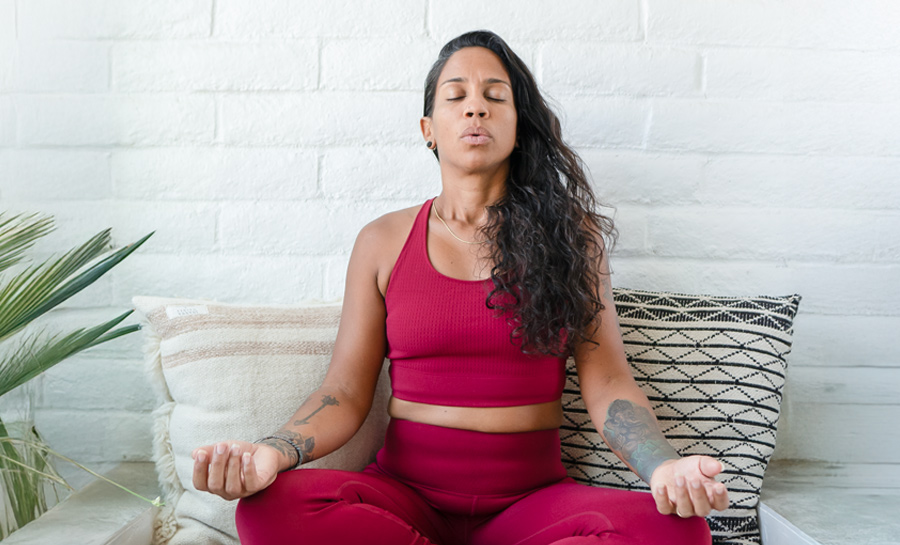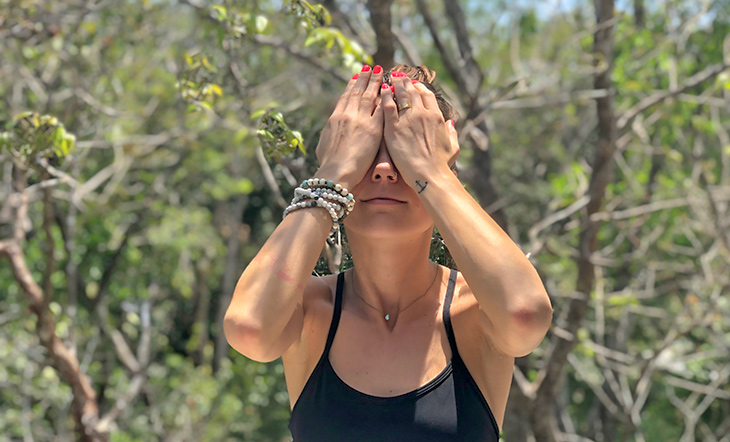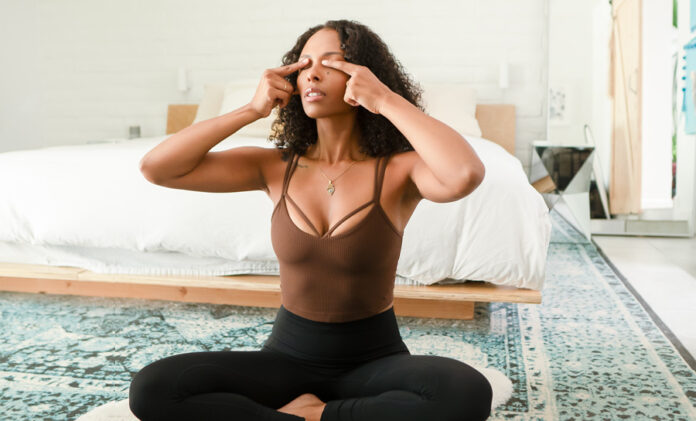When anxiety strikes, it can feel like there’s no time or space to do anything but ride the wave. But what if you could interrupt that cycle with something simple, effective, and fast? Enter: mindfulness practices for anxiety.
So – why mindfulness for anxiety?
Typically, anxiety stems from two points that are not in the present moment: the past or the future. By tuning into the here and now, mindfulness becomes a reassuring anchor and comforting companion. It helps relieve stress, calm anxious thoughts and find peace and equanimity (mental calm and composure even amidst challenging situations).
What Is Mindfulness? Read This Simple Introduction to the Practice
Parts of the below section are adapted from the new book, 101 Mindfulness Practices to Ease Anxiety by Ashton August.
Mindfulness has been practiced for thousands of years. It is a mental practice of being fully aware in the present moment and whatever it contains.
“Smile, breathe, and go slowly.” – Thich Nhat Hanh
Mindfulness is paying attention to the present moment with curiosity and compassion. It invites us to slow down, breathe, and truly notice what’s happening – both around us and within us. And while it’s often associated with long meditations or seated stillness, mindfulness can be woven into even the busiest of days.
As Buddhist Zen Master Thich Nhat Hanh beautifully said, “Smile, breathe, and go slowly.” Mindfulness is less about doing and more about being – coming home to yourself in the moment, with gentleness.
Thich Nhat Hanh and one of his students, Jon Kabat-Zinn helped bring mindfulness to the contemporary mainstream. Scientific studies have shown that mindfulness can reduce stress, improve sleep, lower blood pressure, and improve our overall mental health.
Mindfulness is the practice of paying attention to the present moment with curiosity and compassion.
The truth is, mindfulness doesn’t have to take a lot of time to be powerful. Some of the most effective practices are the shortest. With intention and consistency, even a few conscious breaths can reset your nervous system and help you feel more grounded.
Here Are 5 Mindfulness Practices to Ease Anxiety and Reduce Stress In the Moment:
Here are five research-backed mindfulness practices that you can do in under five minutes – anytime, anywhere – to help calm your mind, regulate your nervous system, and return to yourself.
1. 4-7-8 Breath
This powerful mindfulness for anxiety breathing technique by Dr. Andrew Weil involves inhaling through the nose for a count of 4, holding the breath in for a count of 7, and exhaling through the mouth (as if blowing out a candle) for a count of 8. According to Dr. Weil, the 4-7-8 breath is like “a natural tranquilizer for the nervous system.”
It signals to the brain that you’re safe, activating the parasympathetic nervous system which takes you out of fight or flight mode and in turn soothes your stress and reduces your anxiety in real time. Try 3-5 rounds and then pause and see how you feel. You can return to this breathing technique anytime you feel the need.
Sometimes, especially during heightened anxiety, practices involving breath retention may feel uncomfortable or even increase anxious sensations. If you notice this happening, it’s perfectly okay to pause, try a different practice from this list, and return to breathwork whenever it feels supportive for you.

2. 5-4-3-2-1 Grounding Technique
This simple, widely used grounding technique – often taught in cognitive behavioral therapy (CBT) – can be your go-to for moments of overwhelm. It’s a sensory awareness practice that brings you back into the present by tapping into each of your senses.
Try the 5-4-3-2-1 grounding technique now by taking a moment to name:
- 5 things you can see
- 4 things you can touch
- 3 things you can hear
- 2 things you can smell
- 1 thing you can taste
Why is this mindfulness practice so effective for anxiety reduction? Because so often when we are in an anxious state, we are obsessing over something in the past or worrying about something in the future.
By bringing your awareness to your senses and focusing on your immediate surroundings and sensory experiences, you center yourself in the present moment. Presence interrupts the anxiety loop, helping your mind and body feel grounded and safe.
3. Palming
Palming is a form of DPS, or deep pressure stimulation. By placing your palms gently yet firmly against your closed eyelids, this stimulates your ocular nerves and gives the many muscles in your eyes and face an opportunity to relax.
Palming is also a form of sensory deprivation, which helps reduce the amount of external stimuli your brain is processing to give your nervous system a chance to reset and find calm. By minimizing sensory input, sensory deprivation supports mindfulness by making it easier to focus inward, regulate emotions, and activate the body’s natural relaxation response, all of which help reduce stress and relieve anxiety.

Palming
Curious About Palming and Want to Learn More? Read This
The prerequisite for this mindfulness practice is that you feel comfortable closing or covering your eyes. If you do not, that’s ok – that just means this practice is not for you today!
Rub your palms together to create friction and heat, then gently press them against your closed eyelids. Breathe slowly in and out through your nose. Stay here for several breaths (and you’re welcome to remain longer if you’re loving it). This soothes your nervous system and eases sensory overload.
4. Mindful Hand on Heart
Place one or both hands over your heart, close your eyes, and take 3 deep breaths. As you exhale, say silently: “I am breathing. I am safe. I am present.”
This simple mindfulness practice for anxiety activates the vagus nerve, which plays a major role in regulating your body’s stress response. Stimulating the vagus nerve through this gentle touch and breathwork can lower your heart rate, improve emotional regulation, enhance feelings of connection and safety, and bring a sense of inner peace and groundedness.
Learn All About the Vagus Nerve and How It Can Calm Your Anxious Nervous System
5. One-Minute Body Scan
This mindfulness practice is best experienced lying down, but can also be done sitting in a chair or on the ground with your back against the wall for added support.
Starting at the crown of your head, bring gentle awareness to each area of your body, working your way down to your toes. Move as slowly as you scan, and notice any areas of tension – hover over those areas and breathe into that space until you feel your body soften.
This practice builds interoception (your ability to sense the internal state of your body) and releases stored stress. It also brings you into the present moment and also in your body. Being literally embodied in this way is a helpful mindfulness practice to reduce stress and anxiety.
Interested In Mindfulness Meditation? Here’s How to Get Started (From a Meditation Expert)
Mindfulness for Anxiety Can Be a Game Changer for Your Mental Health
Even if your days feel full or your mind feels scattered, there are still gentle moments of pause available to you. Mindfulness isn’t about perfect stillness – it’s about meeting yourself where you are, with kindness.
As Dr. Judson Brewer, a neuroscientist and psychiatrist, puts it: “The brain is a habit-forming machine. The more we practice awareness and compassion, the more automatic it becomes.”
If you found these practices helpful, 101 Mindfulness Practices to Ease Anxiety is filled with even more tools like these – simple, approachable, and created to support you in everyday life and help gently shift you into a calm state of mind.
Mindfulness practices, like the ones included in this book, increase self-awareness, habitualize self-soothing and emotional regulation, and decrease anxiety while preventing more of it from building up.
Remember: Mindfulness for anxiety doesn’t have to be time-consuming to be effective. These micro-practices are part of a much larger toolkit you can lean on.
Order or learn more about the book from your favorite online retailer: Amazon, Barnes & Noble, Books-A-Million, Books Inc., or Tertulia.












